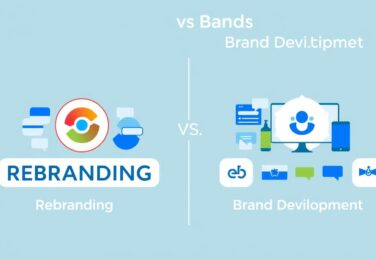Brand Identity vs Brand Strategy Understanding the Key Differences

Table of Content
As a business owner, you’ve put your heart into building your brand. You’ve worked hard on your products, message, and audience connection. But have you thought about the big difference between brand identity and brand strategy?
Many businesses mix up these terms, but knowing their roles is key. Brand identity is about the look and feel of your brand. Brand strategy is about your long-term plan to stand out in the market and reach your goals.
In this article, we’ll explore the main differences between brand identity and strategy. We’ll see why each is important and how to make your brand stand out. By understanding brand development, you’ll be on the path to a thriving business.
Key Takeaways
- Brand identity and brand strategy are distinct but interconnected concepts
- Brand identity focuses on visual and emotional elements, while brand strategy encompasses long-term positioning and goals
- Understanding the differences between brand identity and brand strategy is key for a strong brand
- Good brand identity means consistent visuals, a clear personality, and standing out from others
- Great brand strategy means knowing your audience, setting a clear position, and aiming for measurable goals
What is Brand Identity?
Brand identity is what makes a brand unique. It includes the visual and emotional aspects that show its personality. It’s the first thing customers notice when they see the brand.
A strong brand identity can deeply connect with consumers. It leaves a lasting impression.
The brand identity development process is about creating a consistent image. This includes the website, social media, packaging, and ads. It’s key for building recognition and loyalty.
Visual Elements of Brand Identity
Visual elements are vital in how people see a brand. Key elements include:
- Logo design
- Colour palette
- Typography
- Imagery and photography style
- Packaging design
Being consistent in visual identity is important. It helps create a strong, recognisable brand.
| Element | Consistency | Impact |
|---|---|---|
| Logo | Always use the same logo design across all platforms | Builds brand recognition and trust |
| Colour Palette | Use a consistent set of colours in all visual materials | Creates a strong visual association with the brand |
| Typography | Stick to a specific font family and hierarchy | Enhances readability and reinforces brand personality |
Emotional Connection through Brand Identity
Brand identity also creates an emotional bond with the audience. A well-designed identity can make a brand more relatable and memorable.
A brand is not just a name, term, design, symbol, or any other feature; it is the emotional connection that a consumer develops with the company’s product or service.
By keeping its promise and values, a company can build a strong emotional bond. This leads to more loyalty and advocacy.
Defining Brand Strategy
Brand strategy is a detailed plan that guides a brand’s actions and decisions. It helps achieve long-term goals. It’s the base for all brand strategy work, linking business aims with market and consumer needs.
A good brand strategy includes several important parts:
- Brand positioning strategy: This is how the brand is seen in the market and what makes it stand out from others.
- Target audience: It’s about finding and connecting with the right consumer groups.
- Brand values and personality: These are the core beliefs and traits that make up the brand’s character and voice.
- Brand messaging: It’s about creating messages that are clear, engaging, and speak to the target audience.
To develop a strong brand strategy, you need to really understand the market, what consumers want, and who you’re up against. Doing deep research and analysis helps brands find key insights. These insights shape their brand positioning and overall strategy.
A solid brand strategy acts as a guide for growth. It helps brands tackle challenges and grab opportunities in a changing market. It keeps everything consistent, from product to marketing, making the brand experience clear and memorable.
| Brand Strategy Component | Key Considerations |
|---|---|
| Brand Positioning | Unique value proposition, competitive differentiation |
| Target Audience | Demographics, psychographics, needs and preferences |
| Brand Values and Personality | Core principles, brand archetype, tone and voice |
| Brand Messaging | Key messages, storytelling, content strategy |
By focusing on brand strategy and sticking to it, brands can create deep connections with their audience. This builds loyalty and drives success over the long term.
The Role of Brand Strategy in Business Success
A well-defined brand strategy is key for long-term success in today’s market. It ensures your brand messaging is consistent across all channels. This helps build trust with your audience and reinforces your brand identity.
Here are some key elements to consider when aligning your brand strategy with your business goals:
- Define your brand’s mission and values
- Identify your target audience and their needs
- Develop a unique brand positioning
- Create consistent brand messaging across all touchpoints
It’s also important to stay adaptable in the face of market changes and evolving customer needs. Regularly reassess and adjust your brand strategy to keep your brand relevant and competitive.
Let’s look at a real-world example to see why brand adaptability is important:
| Company | Original Brand Strategy | Market Change | Adapted Brand Strategy |
|---|---|---|---|
| Coca-Cola | Focus on classic Coca-Cola product | Increasing demand for healthier beverages | Expanded product line to include low-sugar and sugar-free options |
Coca-Cola adapted to changing consumer preferences, staying ahead in the beverage market.
Aligning Brand Strategy with Business Goals
Make sure your brand strategy supports your business objectives. This could be increasing market share or launching new products. Regularly check if your strategy aligns with your goals.
Adapting Brand Strategy to Market Changes
Keep an eye on industry changes, consumer behaviour, and competition. Be ready to adjust your strategy to stay relevant. Use customer feedback and market trends to guide your decisions.
By focusing on brand strategy alignment and adaptability, you can ensure long-term success in a changing market.
Key Differences between Brand Identity and Brand Strategy
Brand identity and brand strategy are important but different in brand development. Knowing their differences helps businesses create a strong brand that connects with their audience.
Scope and Focus
Brand identity focuses on what makes a brand stand out visually and emotionally. It includes the logo, colours, fonts, images, and overall look. This makes the brand easy to remember and recognise everywhere.
Brand strategy, on the other hand, looks at the bigger picture. It defines the brand’s purpose, values, and goals. It helps the brand stand out in the market by showing what makes it unique.
Timeframe and Adaptability
Brand identity stays the same over time, with small updates to keep it fresh. The core identity should always be familiar to customers.
Brand strategy, though, can change as the business grows or the market shifts. A good strategy lets the brand adapt and innovate while staying true to its core values.
The following table summarises the key differences between brand identity and brand strategy:
| Brand Identity | Brand Strategy |
|---|---|
| Visual and emotional elements | Purpose, values, positioning, goals |
| Focuses on recognition and memorability | Defines unique value proposition and competitive advantage |
| Consistent and enduring over time | Adaptable to business growth and market changes |
Understanding the differences between brand identity and strategy helps businesses focus their efforts. A strong identity builds an emotional bond with customers. A clear strategy guides the brand’s growth and direction.
Creating a Strong Brand Identity
Building a strong brand identity is key for businesses to stand out. A consistent brand identity helps customers remember and trust your brand. Here are important elements for a strong brand identity.
Consistency in Visual Elements
Keeping a consistent visual identity is vital. Use the same logo, colours, fonts, and images everywhere. This makes your brand easy to remember and builds trust.
Establishing Brand Personality
A unique brand personality connects with your audience. It should show your values and mission. Whether you’re friendly, innovative, or trustworthy, let your personality shine in your visuals and messages.
Differentiating from Competitors
To stand out, differentiate yourself from others. Know what makes you special through market research. Use this to make your brand unique and compelling.
Focus on being consistent, unique, and different to build a strong brand. This will grab attention and create lasting customer relationships.
Developing an Effective Brand Strategy
To create a strong brand, you need to know your audience well, have a clear brand statement, and set goals you can measure. Spending time and resources on these areas helps build a brand that stands out and connects with your customers.

Understanding Your Target Audience
Knowing your audience is key to a good brand strategy. Market research and target audience insights help you understand their needs and preferences. Look at demographics, psychographics, buying habits, and their goals related to your product.
- Demographics (age, gender, income, location)
- Psychographics (values, interests, lifestyle)
- Buying habits and decision-making processes
- Challenges and goals related to your product or service
Use these insights to create buyer personas. This way, you can tailor your brand to speak directly to your ideal customers.
Defining Your Brand Positioning
Your brand positioning strategy tells your audience how you stand out from competitors. It should highlight what makes your brand special and the benefits you offer. Ask yourself:
- What makes our brand unique?
- What value do we offer to our audience?
- How do we want our brand to be seen by customers?
Your positioning statement should be short, memorable, and consistent across all your brand touchpoints.
Setting Measurable Goals
Setting measurable branding goals is vital for your strategy’s success. These goals should match your business objectives and be clear, achievable, and have a deadline. Examples include:
| Goal | Metric | Timeframe |
|---|---|---|
| Increase brand awareness | Website traffic, social media followers, survey results | 6 months |
| Improve brand perception | Customer feedback, net promoter score | 1 year |
| Boost customer loyalty | Repeat purchase rate, customer lifetime value | 2 years |
By tracking these metrics, you can see how well your strategy is working. This helps you make informed decisions to improve your brand over time.
Integrating Brand Identity and Brand Strategy
To make a strong brand, you need to mix your brand identity and strategy well. Your brand identity includes what you look like and how people feel about you. It should match your brand strategy, which outlines who you’re for, where you stand, and what you aim to achieve.
Here are key points to think about when blending your brand identity and strategy:
- Make sure your visuals, like logos and colours, show your brand’s personality and values.
- Share your brand’s special offer everywhere, from your website to social media and ads.
- Match your brand’s message with what your audience likes and needs, based on your strategy.
| Brand | Brand Identity | Brand Strategy | Integration |
|---|---|---|---|
| Bellroy | Minimalist, high-quality wallets and bags | Target audience: young professionals Positioning: sustainable, functional design |
Consistent minimalist look across products and marketing, focusing on sustainability and function |
| Canva | User-friendly graphic design platform | Target audience: small businesses and entrepreneurs Positioning: empowering creativity for all |
Easy-to-use design and lots of templates, backed by welcoming marketing and tutorials |
By merging your brand identity and strategy, you build a unified brand experience. This experience connects with your audience and makes you stand out. Keep checking and updating your brand identity and strategy to stay relevant in a changing market.
Common Mistakes in Brand Strategy Development
Creating a successful brand strategy is key for any business wanting to stand out and connect with its audience. Yet, many companies make mistakes that can hold back their brand’s growth. Let’s look at some common errors in brand strategy development.
Insufficient Market Research
One big mistake is not doing enough market research. Without knowing your audience, competitors, and trends, it’s hard to create a strategy that works. Spending time and money on good research is essential for a strong brand strategy.

Inconsistent Brand Messaging
Another mistake is having mixed messages. If your brand sounds different in every place, it confuses people and weakens your identity. To fix this, make clear guidelines and make sure everyone follows them.
Neglecting to Adapt to Market Changes
Not updating your strategy when the market changes can be expensive. With fast changes in what people want, tech, and competition, your strategy needs to be flexible. Keeping your strategy fresh helps you stay ahead.
“Your brand is the single most important investment you can make in your business.” – Steve Forbes
By avoiding these mistakes and focusing on research, clear messages, and flexibility, you can build a strong brand. This brand will connect with your audience and help your business succeed in the long run.
Conclusion
In today’s business world, knowing the difference between brand identity and strategy is key. Brand identity is about the look and feel of a brand. It’s what makes a brand stand out. On the other hand, brand strategy is the plan for growing and positioning the brand in the market.
Understanding these differences helps businesses create a strong brand. A good brand identity makes a brand memorable and unique. An effective brand strategy, on the other hand, helps achieve business goals and adapt to market changes.
To make your brand stand out, you need a consistent visual identity. This should connect with your audience and set you apart from others. A solid brand strategy is also vital. It should align with your business goals and guide your brand’s direction.
By combining brand identity and strategy, businesses can build a lasting presence. This approach ensures a brand is both memorable and effective in the market.
If you need help with your brand, contact the team at hello@defyn.com.au. They have the expertise to guide you in building a strong brand. Investing in your brand is investing in your company’s future. The right strategy can make a huge difference.










